MicroRNA‑216a‑5p suppresses esophageal squamous cell carcinoma progression by targeting KIAA0101
- PMID: 32901882
- PMCID: PMC7551273
- DOI: 10.3892/or.2020.7751
MicroRNA‑216a‑5p suppresses esophageal squamous cell carcinoma progression by targeting KIAA0101
Abstract
The KIAA0101 protein (also referred to as NS5ATP9 or Paf15) is overexpressed in esophageal squamous cell carcinoma (ESCC) and is associated with disease progression and poor patient survival, but how KIAA0101 expression is regulated remains unknown. The relationship between tumor miR‑216a‑5p expression and prognosis in patients with ESCC was revealed by survival analyses. Quantitative reverse‑transcriptase PCR and western blot analysis were used to evaluate miR‑216a‑5p and KIAA0101 expression in human ESCC tissues and cell lines. The targeting of KIAA0101 by miR‑216a‑5p was verified by dual‑luciferase reporter assays. The EC9706 and TE1 cell lines were transfected with miR‑216a‑5p mimics and inhibitor, or KIAA0101‑specific shRNA and KIAA0101‑expressing plasmids, in order to evaluate the effect of manipulating miR‑216a‑5p and KIAA0101 expression on ESCC cell proliferation, cell cycle progression, migration, and invasion. miR‑216a‑5p was lowly expressed and inversely correlated with KIAA0101 protein expression in ESCC tissues and cell lines. Lower miR‑216a‑5p expression was associated with worse prognosis in patients with ESCC. miR‑216a‑5p negatively regulated KIAA0101 expression by directly targeting the 3'‑untranslated region of the KIAA0101 mRNA. Overexpression of miR‑216a‑5p suppressed the proliferation, migration, and invasion of the ESCC cell lines, whereas inhibition of miR‑216a‑5p had the opposite effects. Meanwhile, KIAA0101 promoted ESCC migration and invasion, and its overexpression abolished the antitumor effects of miR‑216a‑5p mimics. As a tumor suppressor, miR‑216a‑5p targets KIAA0101 to inhibit the proliferation, migration, and invasion of ESCC. Therefore, the miR‑216a‑5p/KIAA0101 axis may be a potential target for ESCC treatment.
Keywords: microRNA; miR-216a-5p; esophageal squamous cell carcinoma; KIAA0101; disease progression.
Figures
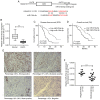
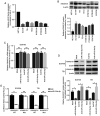

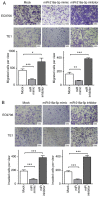
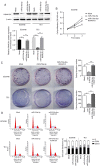

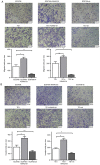
References
MeSH terms
Substances
LinkOut - more resources
Full Text Sources
Medical
Research Materials

